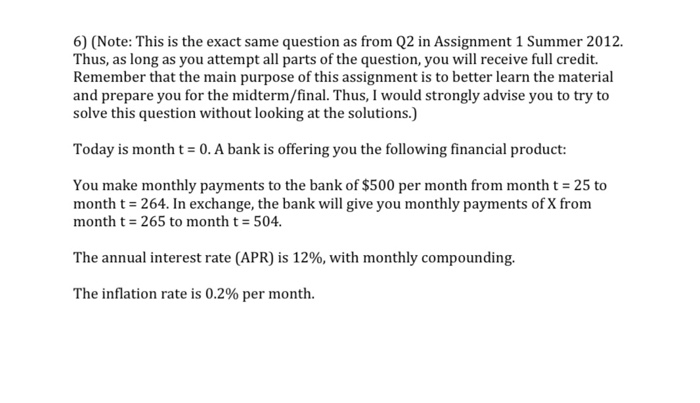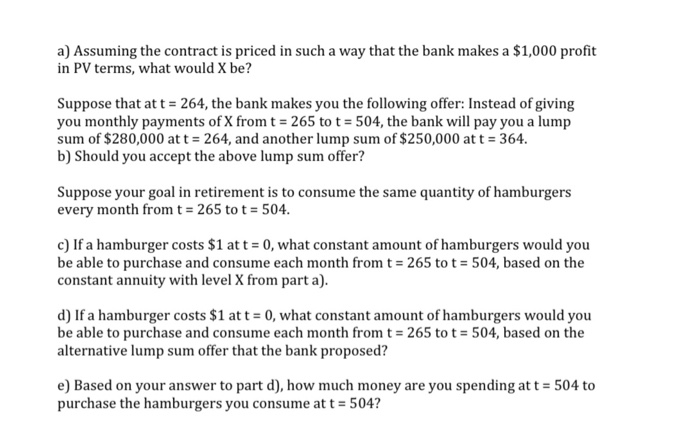6) (Note: This is the exact same question as from Q2 in Assignment 1 Summer 2012. Thus, as long as you attempt all parts of the question, you will receive full credit. Remember that the main purpose of this assignment is to better learn the material and prepare you for the midterm/final. Thus, I would strongly advise you to try to solve this question without looking at the solutions.) Today is month t = 0. A bank is offering you the following financial product: You make monthly payments to the bank of $500 per month from month t = 25 to month t = 264. In exchange, the bank will give you monthly payments of X from month t = 265 to month t = 504. The annual interest rate (APR) is 12%, with monthly compounding, The inflation rate is 0.2% per month. a) Assuming the contract is priced in such a way that the bank makes a $1,000 profit in PV terms, what would X be? Suppose that at t = 264, the bank makes you the following offer: Instead of giving you monthly payments of X from t = 265 to t = 504, the bank will pay you a lump sum of $280,000 at t = 264, and another lump sum of $250,000 at t = 364. b) Should you accept the above lump sum offer? Suppose your goal in retirement is to consume the same quantity of hamburgers every month from t = 265 to t = 504. c) If a hamburger costs $1 at t = 0, what constant amount of hamburgers would you be able to purchase and consume each month from t = 265 to t = 504, based on the constant annuity with level X from part a). d) If a hamburger costs $1 at t = 0, what constant amount of hamburgers would you be able to purchase and consume each month from t = 265 to t = 504, based on the alternative lump sum offer that the bank proposed? e) Based on your answer to part d), how much money are you spending at t = 504 to purchase the hamburgers you consume at t = 504? 6) (Note: This is the exact same question as from Q2 in Assignment 1 Summer 2012. Thus, as long as you attempt all parts of the question, you will receive full credit. Remember that the main purpose of this assignment is to better learn the material and prepare you for the midterm/final. Thus, I would strongly advise you to try to solve this question without looking at the solutions.) Today is month t = 0. A bank is offering you the following financial product: You make monthly payments to the bank of $500 per month from month t = 25 to month t = 264. In exchange, the bank will give you monthly payments of X from month t = 265 to month t = 504. The annual interest rate (APR) is 12%, with monthly compounding, The inflation rate is 0.2% per month. a) Assuming the contract is priced in such a way that the bank makes a $1,000 profit in PV terms, what would X be? Suppose that at t = 264, the bank makes you the following offer: Instead of giving you monthly payments of X from t = 265 to t = 504, the bank will pay you a lump sum of $280,000 at t = 264, and another lump sum of $250,000 at t = 364. b) Should you accept the above lump sum offer? Suppose your goal in retirement is to consume the same quantity of hamburgers every month from t = 265 to t = 504. c) If a hamburger costs $1 at t = 0, what constant amount of hamburgers would you be able to purchase and consume each month from t = 265 to t = 504, based on the constant annuity with level X from part a). d) If a hamburger costs $1 at t = 0, what constant amount of hamburgers would you be able to purchase and consume each month from t = 265 to t = 504, based on the alternative lump sum offer that the bank proposed? e) Based on your answer to part d), how much money are you spending at t = 504 to purchase the hamburgers you consume at t = 504








